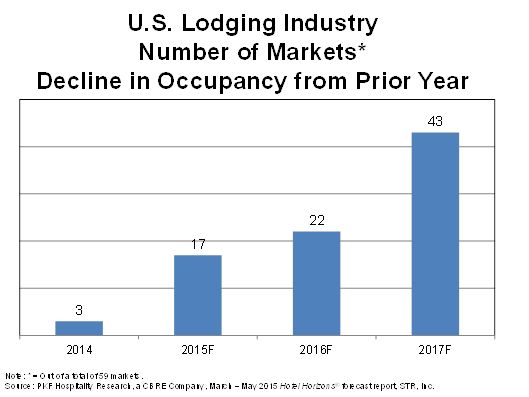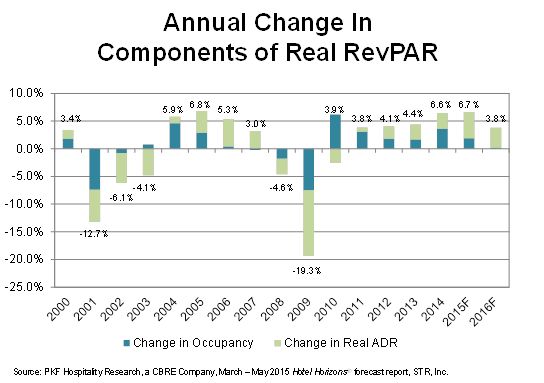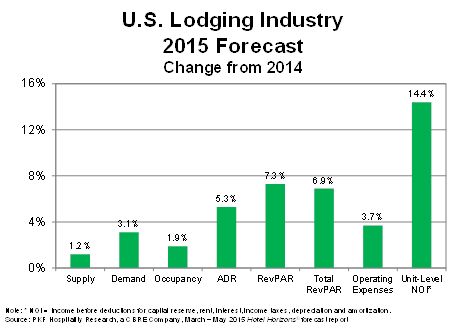PKF-HR Forecasts A Shift In the Drivers Of RevPAR Growth
March 16, 2015, Atlanta, Ga. – The U.S. lodging industry will continue to achieve very strong growth in rooms revenue per available room (RevPAR) during both 2015 and 2016 according to the recently released March 2015 edition of PKF Hospitality Research’s (PKF-HR) Hotel Horizons® (PKF-HR is a CBRE company). The report further predicts that the composition of the factors driving the RevPAR is starting to shift with record-setting occupancy yielding ground to growing average daily rates (ADR).
“In 2015, RevPAR growth will be achieved by healthy increases in both occupancy and ADR, similar to the pattern we have seen since 2011,” said R. Mark Woodworth, senior managing director of PKF-HR. “However, beginning in 2016, we are forecasting that ADR gains will be the dominant, if not sole, driver of RevPAR growth through 2019.”
For 2015, PKF-HR is forecasting a 1.9 percent increase in occupancy, combined with a 5.3 percent rise in ADR, for a 7.3 percent boost to RevPAR. In 2016, the increase in occupancy is projected to slow down to just 0.6 percent, but the pace of ADR growth is forecast to improve to 6.3 percent. The net result will be a 6.5 percent gain in RevPAR next year.
“The 65.6 percent occupancy level we are forecasting for 2015 is an all-time record for the 27 years STR, Inc. has been reporting U.S. lodging industry performance. At such lofty levels, it is natural that the pace of occupancy growth will slow down, and we will start to see prices take off,” said Woodworth.
Are The Gains Real?
“When discussing ADR and RevPAR growth, you should always evaluate them in real terms, not just nominal,” said John B. (Jack) Corgel, Ph.D., the Robert C. Baker professor of real estate at the Cornell University School of Hotel Administration and senior advisor to PKF-HR. “Hotel owners and managers financially benefit from real dollar flows which occur when demand exceeds supply for hotel rooms as it has during this recovery and expansion and will into the near future.”
According to CBRE Economic Advisors and Moody’s Analytics, inflation in 2015 is forecast to be a mere 0.6 percent. However, in 2016, as the price of oil and other commodities start to rise, the inflation forecast jumps to 2.6 percent.
“Taking inflation into consideration, we do see a slightly different RevPAR outlook each of the next two years,” Corgel said. “In the low-inflationary environment of 2015, the real RevPAR gain is projected to be 6.7 percent, the strongest growth in real RevPAR since 2005. The combination of low occupancy growth and rising inflation nets a real RevPAR gain of 3.8 percent in 2016.”
“The slowdown in the pace of real RevPAR growth next year might alarm some owners and operators,” Woodworth said. “However, it is important to note that the 3.6 percent real gain in ADR forecast for 2016 is still well above the real ADR gains we have observed over the past 20 years. Real ADR growth, combined with a limited increase in the variable expenses due to the slowdown in occupancy growth, should yield some very attractive improvements in net operating income in 2016.”
PKF-HR is forecasting gains in excess of 10 percent for both 2015 and 2016 for unit-level net operating income, extending the streak of double-digit increases in hotel profits to six consecutive years.
Market Forecasts Foretell
Analyzing the projected performance of the nation’s major markets reveals a clear picture of the future of the U.S. lodging industry. In 2015, New York, Austin, and Pittsburgh are forecast to experience the greatest increases in supply and concurrently the three lowest levels of RevPAR gains for the year.
“Localized surges in supply are creating declines in occupancy, which in turn results in suppressed RevPAR growth. Clearly this is going to occur in more and more cities over the next few years,” Woodworth noted. According to STR, Inc., just three of the 59 markets in the Hotel Horizons® survey suffered a decline in occupancy during 2014. Woodworth said he expects an increase to 17 markets in 2015, followed by 22 markets in 2016.
“Fortunately occupancy rates in most markets are expected to remain above long-run levels, thus allowing for sizeable growth in real ADR,” said Woodworth. PKF-HR is not forecasting the national supply growth to exceed the long-run average until 2017.
“By any measure, 2015 and 2016 will two more years of strong performance for U.S. hotel owners and operators. Beyond 2016, the impacts of rising supply and inflation will begin to curb some of the record annual performance growth rates U.S. hoteliers have enjoyed since 2011,” Woodworth concluded.
* * *
To purchase a March 2015 Hotel Horizons® report, please visit store.pkfc.com. Reports are available for each of 59 major metropolitan areas in the U.S., and contain five year projections of supply, demand, occupancy, ADR, and RevPAR.




